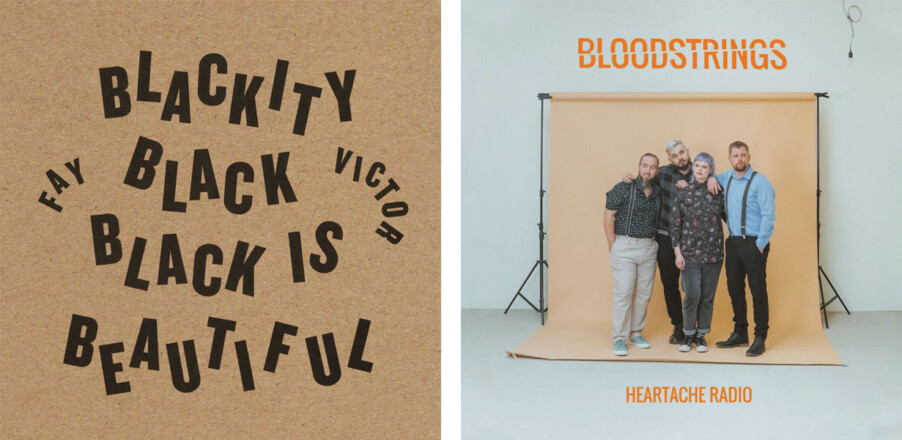Fay Victor, Blackity Black Black Is Beautiful (Northern Spy Records)
This record is definitely in the same church if not the same pew as most slam poetry, and while I’m at this, if you’ve had the slightest interest in the ongoing saga involving my attending a Slam Free Or Die slam poetry event here in Manchester, I’m happy to say that the show’s organizer, Christopher Clauss, contacted me the other day and I’m hoping to get to their next show on Aug. 3, which will feature Chicago veteran slam poet Billy Tuggle. As for this album, it’s the Brooklyn-based composer’s first solo record in a thus-far 30-year career whose highlights have included distinguished prize awards, lots of performances in museums, jazz festivals and the like. Her trip is layering her own spoken word poetry and melodic soul/gospel vocalizations over techno, glitch, acid jazz, more glitch and various other beats, her lyrics intended to raise awareness about the things and public figures she holds dear (“Governorship/Senate” is dedicated to Stacey Abrams; the spooky-bizarre “Trust The Universe” to Sun Ra). Fascinating urban art piece, all told. A
Bloodstrings, Heartache Radio (Dackelton Records)
This one had me at “horror psychobilly” but even more so when I noticed they’re Germans. If anyone knows how to conjure drunken, boneheaded American-style punk aggression, it’s Europeans, especially when they’re from countries that aren’t France. This lot have been around since 2009 and mostly did a lusty Ramones-goth thing until the present, which finds the poor dears feeling reflective after losing a few friends to depression and such, which is always horrible, and so, instead of singing about cartoonish fantasy demons, the demons examined in this record are the real ones, for instance the demons of addiction in “The Bottle Talking,” a great little punker that sounds like No Doubt-era Gwen Stefani fronting Hole. The production here is absolutely sparkling, totally pro level, which makes the deranged thrasher “Colorblind” sound like the Runaways on a Green Day budget. Not a lot of punkabilly here, just nicely rendered hardcore for the most part, but there’s nothing wrong with that of course. A
Playlist
• Ack, I hate it, look, the next CD-release Friday is July 21, summer’s already more than half gone, where’s my confounded snowshoes? Ack, but it’s even worse, because look fam, it’s depleted-soil Led Zeppelin wannabes Greta Van Fleet, with their latest album of Zeppelin IV ripoff songs, Starcatcher! I saw a recent YouTube “reaction-style” video where some 20-year-old dude was, he swore, listening to Zep’s “Whole Lotta Love” for the first time, and he was surprised at how much he liked it. Like all olds, it’s impossible for me to believe that someone’s never heard that boring old tune before, but remember, fellow olds, these kids today aren’t listening to 50-year-old songs when they make out in their moms’ Toyota Camrys, they’ve got all kinds of commercial hip-hop and K-pop and Weeknd and Kings Of Leon songs on little thumb drives, and because of that, they don’t tune mom’s car radio away from NPR’s Marketplace or Sirius’s 80s On 8, and because of that, mom has no idea how vacuous and wimpy and empty their preferred music is, and that’s good, because you know what that is? It’s teenage rebellion, folks, kids exercising their right not to listen to Led Zeppelin and Def Leppard until they’re older, saving up all that “good stuff” until they’re old enough to appreciate it, so they can make reaction YouTubes and then immediately go back to listening to their Bruno Mars and Lorde “oldies records” and never have to listen to that old blues-metal nonsense again. See, kids today are smart; they know that Led Zeppelin is actual devil music, direct from H-E-double-toothpicks, and if they’re not careful, they’ll get sucked into the same Evil Dead time-space vortex that the guys in Greta Van Fleet did, which caused those dummies to try to rewrite Zep’s “Black Dog” every album until they get it sounding better than the original, which they obviously can’t, but look how hard they try! Anyway meanwhile, back at the column, the Fleets have graced us with a new song called “Meeting The Master,” and it’s basically Zep’s “The Rain Song” turned inside out and made into a quirky hat. I have no more time to discuss this, thank goodness.
• Ack, wait what, not a new Guided by Voices album, this cannot be, will Robert Pollard ever take a break from writing five boring new songs every 10 minutes and insisting on recording them? Ever see the end of the 1970s version of Planet Of The Apes, when Charlton Heston is pounding sand and cursing at the sky? Well, that’s me every 15 minutes, when I read that a new GBV album is coming out in time for mention in this column. If you’re keeping count, we’re now at eight GBV albums in three years, and this one’s titled Welshpool Frillies. The single, “Seedling,” is like an angular art-rock version of Yardbirds. It’s not totally bad, but you can tell Pollard wrote it on the potty in 10 minutes, like all his other songs. What-ever.
• Nils Lofgren is in Bruce Springsteen’s E Street Band, which isn’t necessarily a reason to hate him. In between making Bruuuce albums he makes his own albums, like the forthcoming new Mountains, which is on the way to your pirate music feeds as we speak. In the leadoff single, “Nothin’s Easy (For Amy),” Nils sings like a cross between Willie Nelson and Neil Young, and the refried Americana-bluegrass underneath his voice is even worse. Enjoy, fans of Bruuuce!
• We’ll end the week with not particularly funny comedian/musician Jaboukie Young-White’s new album, All Who Can’t Hear Must Feel, featuring the single “Goner,” whose haunted-house-meets-industrial beat is, I must admit, pretty gosh-darn above-average.
If you’re in a local band, now’s a great time to let me know about your EP, your single, whatever’s on your mind. Let me know how you’re holding yourself together without being able to play shows or jam with your homies. Send a recipe for keema matar. Message me on Twitter (@esaeger) or Facebook (eric.saeger.9).






